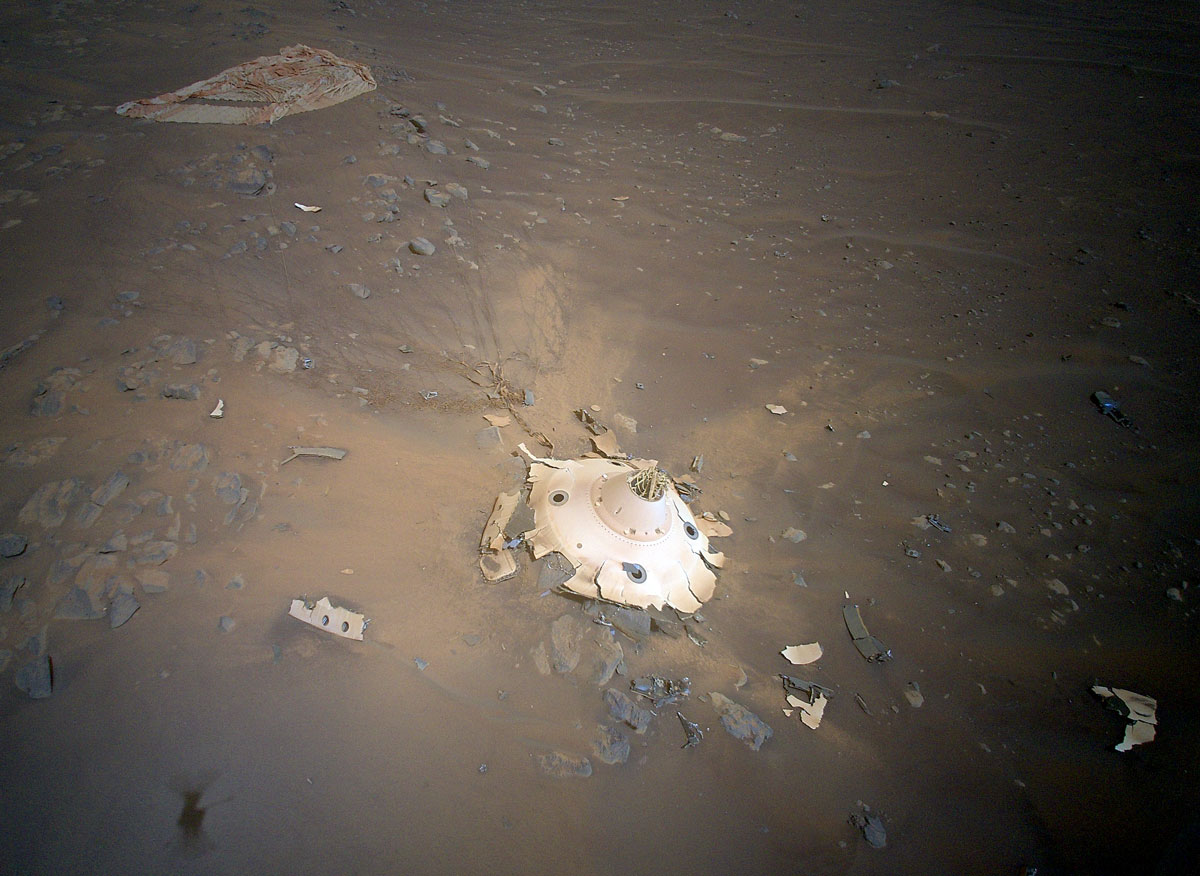A recent blog by Dr. Justin Maki, Imaging Scientist and the Deputy Principal Investigator on the Perseverance rover Mastcam-Z camera, provides a detailed account about the debris the entry, descent, and landing (EDL) system left scattered around the Martian surface while delivering the Perseverance rover to Jezero Crater. This blog highlights how much hardware goes into sending our brave, robotic explorers to the Red Planet while discussing the importance of imaging such debris.
“For example, on Sol 414 (April 19, 2022), the Ingenuity helicopter returned a detailed color image of the discarded parachute and backshell located 1 km to the northwest of the landing site.” Dr. Maki writes. But how important is it to locate and identify debris from past missions on Mars?

Dr. Briony Horgan, Co-Investigator of the Perseverance rover and an Associate Professor of Planetary Science in the Department of Earth, Atmospheric, and Planetary Sciences at Purdue University said, “The contamination concerns are pretty minor, but we actually do use hardware on the surface to track dust accumulation!” The parachutes are especially good for this and measuring their brightness over time can help us understand how dust deposition is changing over time due to local weather conditions.”
Dr. Maki continues in his blog, “A few weeks later, Perseverance entered the Hogwallow Flats region and acquired a high-resolution, 360-degree Mastcam-Z panorama. As those images were being downlinked to Earth, a science team member in Europe spotted the bright material (at 2:50 AM Pacific time) in a Sol 467 (June 12, 2022) Mastcam-Z image and immediately suggested that it might be a piece of debris from the Entry, Decent, and Landing (EDL) system. Later that morning it was confirmed by the EDL hardware team at JPL: Perseverance had imaged a piece of multi-layer insulation (MLI), likely from the skycrane, which flew away from Perseverance’s landing site after touchdown, ensuring it would crash safely out of range from the rover.” But with debris being scattered around the Martian surface, can it interfere with Perseverance rover operations?

“Mars 2020 includes several design features to guard against this type of debris interfering with rover operations.,” said Steven Lee, who is the Deputy Project Manager for Mars Science Laboratory/Curiosity. “The presence of debris on the ground in itself does not pose a risk to Perseverance’s mission. Only two rover components could touch debris on the ground. First, the mobility system is designed to be robust to a wide variety of terrain types and could easily drive right over this debris. Likewise, the sampling system is designed to operate in an environment with dust and pebbles (including dust and pebbles created during abrading or coring). We also occasionally perform a “percuss to clean chuck” operation to shake material out of the corer’s chuck.”
NASA’s Perseverance rover isn’t the first Mars rover to photograph its own debris, as Dr. Maki states in his blog, “The Mars Exploration Rover (MER) Opportunity rover imaged a heatshield up close on Sol 335 (January 2, 2004) of the surface mission. Those images revealed a debris field that stretched several meters, and included charred heatshield material, metal springs, and thermal blanket material. The Curiosity images also showed a rock (“heatshield rock”) that is believed to be a meteorite – the original version of EDL debris.” Going forward, what specific steps can be taken to reduce this debris on future missions?

“For the moment, the number of missions that we’ve landed on Mars has been so small that it’s a very minor contributor to the surface,” said Dr. Horgan. “And I like to imagine that one day future Mars inhabitants will preserve these historic spacecraft landing sites and the hardware, perhaps as the first interplanetary parks!”
As always, keep doing science & keep looking up!

